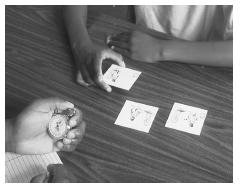Wechsler Intelligence Scale for Children

Definition
The Wechsler Intelligence Scale for Children, often abbreviated as WISC, is an individually administered measure of intelligence intended for children aged six years to 16 years and 11 months.
Purpose
The WISC is designed to measure human intelligence as reflected in both verbal and nonverbal (performance) abilities. David Wechsler, the author of the test, believed that intelligence has a global quality that reflects a variety of measurable skills. He also thought that it should be considered in the context of the person's overall personality.
The WISC is used in schools as part of placement evaluations for programs for gifted children and for children who are developmentally disabled.
In addition to its uses in intelligence assessment, the WISC is used in neuropsychological evaluation, specifically with regard to brain dysfunction. Large differences in verbal and nonverbal intelligence may indicate specific types of brain damage.
The WISC is also used for other diagnostic purposes. IQ scores reported by the WISC can be used as part of the diagnostic criteria for mental retardation and specific learning disabilities. The test may also serve to better evaluate children with attention-deficit/hyperactivity disorder (ADHD) and other behavior disorders.
Precautions
The Wechsler intelligence scales are not considered adequate measures of extreme intelligence (IQ scores below 40 and above 160). The scoring process does not allow for scores outside this range for test takers at particular ages. Wechsler himself was even more conservative, stressing that his scales were not appropriate for people with IQs below 70 or above 130. Despite this restriction, many people use the WISC as a measure of the intelligence of gifted children, who typically score above 130. The age range for the WISC overlaps with that of the Wechsler Adult Intelligence Scale (WAIS) for people between 16 and 17 years of age, but experts suggest that the WISC provides a better measure for people in this age range.
Administration and scoring of the WISC require a competent administrator who must be able to interact and communicate with children of different ages and must know test protocol and specifications. WISC administrators must receive training in the proper use of the instrument and demonstrate awareness of all test guidelines.
Description
The Wechsler intelligence tests , which include the WISC, the WAIS, and the WPPSI (Wechsler Preschool and Primary Scale of Intelligence), are the most widely used intelligence and neuropsychological assessments. The first version of the WISC was written in 1949 by David Wechsler. The newest version of the WISC is the WISC-III (Wechsler Intelligence Scale for Children-Third Edition, most recently updated in 1991). Since Wechsler's death in 1981, the tests have been revised by their publisher, the Psychological Corporation.
The theoretical basis for the WISC and the other Wechsler scales is Wechsler's belief that human intelligence is a complex ability involving a variety of skills. Because intelligence is multifaceted, Wechsler believed, a test measuring intelligence must reflect this diversity. After dividing intelligence into two major types of skills—verbal and performance—Wechsler used a statistical technique called factor analysis to determine which specific skills fit within these two major domains.
The current version of the WISC (the WISC-III) consists of 13 subtests and takes between 50 and 75 minutes to complete. The test is taken individually, with an administrator present to give instructions. Each subtest is given separately. There is some flexibility in the administration of the WISC—the administrator may end some subtests early if the test taker appears to have reached the limit of his or her capacity. Tasks on the WISC include questions of general knowledge, traditional arithmetic problems, English vocabulary, completion of mazes, and arrangements of blocks and pictures.
Children who take the WISC are scored by comparing their performance to other test takers of the same age. The WISC yields three IQ (intelligence quotient) scores, based on an average of 100, as well as subtest and index scores. WISC subtests measure specific verbal and performance abilities. The Wecshler scales were originally developed and later revised using standardization samples. The samples were meant to be representative of the United States population at the time of standardization.
The WISC is considered to be a valid and reliable measure of general intelligence in children. It is regularly used by researchers in many areas of psychology and child development as a general measure of intelligence. It has also been found to be a good measure of both fluid and crystallized intelligence. Fluid intelligence refers to inductive and deductive reasoning, skills that are thought to be largely influenced by neurological and biological factors. Fluid intelligence is measured by the performance subtests of the WISC. Crystallized intelligence refers to knowledge and skills that are primarily influenced by environmental and sociocultural factors. It is measured by the verbal subtests of the WISC. Wechsler himself did not divide overall intelligence into these two types. The definition of fluid and crystallized intelligence as two major categories of cognitive ability, however, has been a focus of research for many intelligence theorists.
Verbal IQ
The child's verbal IQ score is derived from scores on six of the subtests: information, digit span, vocabulary, arithmetic, comprehension, and similarities.
The information subtest is a test of general knowledge, including questions about geography and literature. The digit span subtest requires the child to repeat strings of digits recited by the examiner. The vocabulary and arithmetic subtests are general measures of the child's vocabulary and arithmetic skills. The comprehension subtest asks the child to solve practical problems and explain the meaning of simple proverbs. The similarities subtest asks the child to describe the similarities between pairs of items, for example that apples and oranges are both fruits.
Performance IQ
The child's performance IQ is derived from scores on the remaining seven subtests: picture completion, picture arrangement, block design, object assembly, coding, mazes, and symbol search.
In the picture completion subtest, the child is asked to complete pictures with missing elements. The picture arrangement subtest entails arranging pictures in order to tell a story. The block design subtest requires the child to use blocks to make specific designs. The object assembly subtest asks the child to put together pieces in such a way as to construct an entire object. In the coding subtest, the child makes pairs from a series of shapes or numbers. The mazes subtest asks the child to solve maze puzzles of increasing difficulty. The symbol search subtest requires the child to match symbols that appear in different groups. Scores on the performance subtests are based on both the speed of response and the number of correct answers.
Results
WISC scores yield an overall intelligence quotient, called the full scale IQ, as well as a verbal IQ and a performance IQ. The three IQ scores are standardized in such a way that a score of 100 is considered average and serves as a benchmark for higher and lower scores. Verbal and performance IQ scores are based on scores on the 13 subtests.
The full scale IQ is derived from the child's scores on all of the subtests. It reflects both verbal IQ and performance

See also
Resources
BOOKS
Groth-Marnat, Gary. Handbook of Psychological Assessment. 3rd edition. New York: John Wiley and Sons, 1997.
Kline, Paul. The Handbook of Psychological Testing. New York: Routledge, 1999.
McGrew, Kevin S., and Dawn P. Flanagan. The Intelligence Test Desk Reference. Needham Heights, MA: Allyn and Bacon, 1998.
Ali Fahmy, Ph.D.
Can I see some sample questions from WISC ?
Thank you.